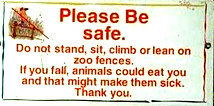It seems Jericho fans had plenty of reason to cheer this week. CBS recognized fans for sending custom label water bottles; launched a blog called The Salty Scoop; made plans to promote Jericho Season 2 at Comic-Con in San Diego; and sent out a promising message from Nina Tassler, president of CBS Entertainment, publicly stating that while the rerun ratings are modest, 23 percent of the viewers currently watching first season Jericho reruns never watched the show before (hat tip to Jericho Saved).
“Just as encouraging, this research shows that one million viewers who left the show after the mid-season hiatus have returned this summer to catch up on the episodes they missed,” Tassler said. “We still have a LONG way to go. But, I wanted to share this news and express our continued appreciation for your support of " Jericho." You have quickly and firmly established "Jericho" as the show with the most passionate and vocal fan community on television. Please keep spreading the word.”
All right. We’ll lend an unofficial assist that we will promote deep …
Every now and again, I have an idea that I want to see come to fruition. One of them is the expansion of the Jericho Universe. While the waters have been tested a bit by fans, we kicked an idea around the office last week on how we might capture new viewers while expanding the Jericho Universe. Done.
Expanded Universe Short Story Competition
The Story. Write a 250- to 1,000-word short story about something happening in the expanded universe of Jericho (outside of Jericho) with original characters. While Jericho can be mentioned, please refrain from using anything that may interfere with future plot lines. Your name and address must be included on the e-mailed entry (we will publish pseudonyms upon request).
The Submission. Please submit the story in the body of an e-mail (no attachments, please) to expanduniverse@yahoo.com by no later than 5 p.m. PST on Aug. 17, 2007.
Entry fee. Nada. Zero.
First Place.
• The story published on the Copywrite, Ink. blog on Sept. 2, 2007
• An authentic hand-signed autographed picture of Skeet Ulrich (above)
• Jericho - The first season on DVD (upon release)
- The first season on DVD (upon release)
• Choice of Copywrite, Ink. “Covering Nuts” or “Remember Jericho” T-shirt
Second Place.
• The story published on the Copywrite, Ink. blog on Sept. 9, 2007
• Jericho – Official 11x17 reproduction poster
– Official 11x17 reproduction poster
• Choice of Copywrite, Ink. “Covering Nuts” or “Remember Jericho” T-shirt
Third Place.
• The story published on the Copywrite, Ink. blog on Sept. 16, 2007
• Choice of Copywrite, Ink. “Covering Nuts” or “Remember Jericho” T-shirt
Winners will be announced on Aug. 31, 2007. Entry assumes that you agree to grant us first electronic rights (only) for publication on this blog in the event you win. If you do not win, you retain all rights. And by entering, you also agree that the story you submit is your own original work.
Tips. As we tell any writers, be accurate, clear, concise, human, and conspicuous. Since we are writers, spelling and grammar count. We also reserve the right to edit the stories and/or not award some or all prizes if no suitable entries are submitted.
If you are unfamiliar with Jericho, you might visit the Emmy-nominated site for backgrounders. If you have any questions, feel free to comment.
If you need additional inspiration, visit tomorrow because I’ll be posting a fan-fiction piece that I wrote last weekend (geez, hope you like it). Naturally, my example is not eligible to win nor can anyone else employed by Copywrite, Ink. enter.
Disclaimer: "Jericho” and its related characters are the property of CBS Paramount Television Network and Junction Entertainment. This contest is solely for entertainment purposes. Copywrite, Ink. is not affiliated with CBS or Junction Entertainment.

“Just as encouraging, this research shows that one million viewers who left the show after the mid-season hiatus have returned this summer to catch up on the episodes they missed,” Tassler said. “We still have a LONG way to go. But, I wanted to share this news and express our continued appreciation for your support of " Jericho." You have quickly and firmly established "Jericho" as the show with the most passionate and vocal fan community on television. Please keep spreading the word.”
All right. We’ll lend an unofficial assist that we will promote deep …
Every now and again, I have an idea that I want to see come to fruition. One of them is the expansion of the Jericho Universe. While the waters have been tested a bit by fans, we kicked an idea around the office last week on how we might capture new viewers while expanding the Jericho Universe. Done.
Expanded Universe Short Story Competition
The Story. Write a 250- to 1,000-word short story about something happening in the expanded universe of Jericho (outside of Jericho) with original characters. While Jericho can be mentioned, please refrain from using anything that may interfere with future plot lines. Your name and address must be included on the e-mailed entry (we will publish pseudonyms upon request).
The Submission. Please submit the story in the body of an e-mail (no attachments, please) to expanduniverse@yahoo.com by no later than 5 p.m. PST on Aug. 17, 2007.
Entry fee. Nada. Zero.
First Place.
• The story published on the Copywrite, Ink. blog on Sept. 2, 2007
• An authentic hand-signed autographed picture of Skeet Ulrich (above)
• Jericho
• Choice of Copywrite, Ink. “Covering Nuts” or “Remember Jericho” T-shirt
Second Place.
• The story published on the Copywrite, Ink. blog on Sept. 9, 2007
• Jericho
• Choice of Copywrite, Ink. “Covering Nuts” or “Remember Jericho” T-shirt
Third Place.
• The story published on the Copywrite, Ink. blog on Sept. 16, 2007
• Choice of Copywrite, Ink. “Covering Nuts” or “Remember Jericho” T-shirt
Winners will be announced on Aug. 31, 2007. Entry assumes that you agree to grant us first electronic rights (only) for publication on this blog in the event you win. If you do not win, you retain all rights. And by entering, you also agree that the story you submit is your own original work.
Tips. As we tell any writers, be accurate, clear, concise, human, and conspicuous. Since we are writers, spelling and grammar count. We also reserve the right to edit the stories and/or not award some or all prizes if no suitable entries are submitted.
If you are unfamiliar with Jericho, you might visit the Emmy-nominated site for backgrounders. If you have any questions, feel free to comment.
If you need additional inspiration, visit tomorrow because I’ll be posting a fan-fiction piece that I wrote last weekend (geez, hope you like it). Naturally, my example is not eligible to win nor can anyone else employed by Copywrite, Ink. enter.
Disclaimer: "Jericho” and its related characters are the property of CBS Paramount Television Network and Junction Entertainment. This contest is solely for entertainment purposes. Copywrite, Ink. is not affiliated with CBS or Junction Entertainment.





















